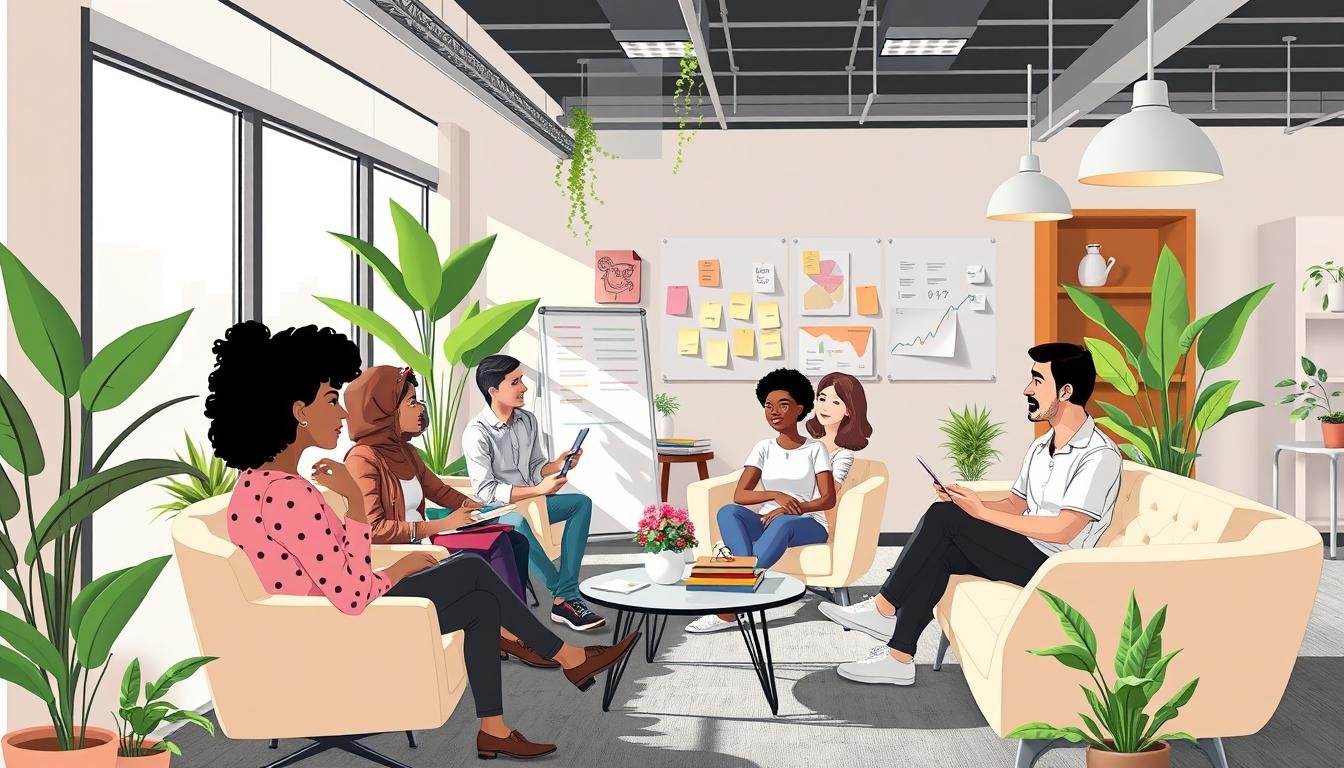Creating a Psychologically Safe Workplace: A Step-by-Step Guide
Ever wondered why some teams do great while others don’t? It might be because of psychological safety. This important idea is often missed but can really change a company’s success.
Psychological safety is more than just a term; it’s a key to success. It lets employees share their thoughts, make mistakes, and try new things without fear. This freedom boosts productivity, keeps employees happy, and supports diversity and inclusion.
Studies show that safe workplaces do better than others. They see 260% more motivation, 41% fewer sick days, and 50% less job hunting. This shows that safety is good for both employees and the company.
But, there’s a problem. While 93% of top leaders feel safe, only 86% of workers do. This shows we need a clear plan to make everyone feel safe at work.
Key Takeaways
- Psychological safety boosts innovation and productivity
- It reduces employee turnover and sick days
- There’s a perception gap between executives and employees
- Building trust is crucial for psychological safety
- Open communication and learning from mistakes are key components
- Leadership plays a vital role in fostering psychological safety
Understanding Psychological Safety in the Workplace
Psychological safety is key to a great workplace. It means you can speak up without fear of getting in trouble. This is important for innovation, learning, and growth.
Definition and Importance
Psychological safety lets employees feel safe to take risks and share ideas. A survey showed 89% of employees think it’s crucial. It shows how important it is in today’s work world.
Benefits for Teams and Organizations
Companies that focus on psychological safety gain a lot. They see more productivity, creativity, and happy employees. Studies show that investing in leadership makes employees feel more included.
This makes the company more agile and ready for new ideas.
Key Components of Psychological Safety
Psychological safety is built on a few important things:
- Open communication: Encourages sharing ideas and concerns
- Trust: Builds confidence among team members
- Risk-taking: Supports taking risks and learning from failures
- Innovation: Celebrates diverse ideas
By focusing on these, companies can make a workplace where employees feel valued. This leads to better engagement, problem-solving, and success.
Assessing Your Current Workplace Culture
Understanding your team dynamics is key. Start by doing anonymous surveys to see how employees feel about safety. This helps spot where you can get better and improve the culture.
When checking your workplace, look at these important points:
- How mistakes are handled
- Comfort level in sharing ideas
- Inclusion of diverse perspectives
Using specific surveys for psychological safety can lead to better results. These surveys give you real data and reports you can use to check how healthy your organization is.
“Creating a sense of trust and psychological safety is essential for fostering creativity in the workplace.”
To really understand, mix both numbers and stories. This way, you can see how people feel about being included and if they can question things.
| Assessment Method | Benefits |
|---|---|
| Anonymous Surveys | Honest feedback, data-driven insights |
| One-on-One Conversations | Personal context, detailed understanding |
| Team Discussions | Collective insights, shared experiences |
Creating a safe workplace is an ongoing job. Regular checks help you see how you’re doing and where you can get better. This keeps your workplace positive and productive.
Leadership’s Role in Fostering Psychological Safety
Leaders are key in making a workplace safe for everyone’s mind. Their skills and emotional smarts help teams feel okay to try new things and share ideas. Let’s see how leaders can build a safe space for everyone.
Leading by Example
Good leaders show they can be vulnerable and talk about their mistakes. This makes team members feel safe to share their thoughts and worries. Sadly, only a few leaders really make their teams feel safe, a McKinsey Global Survey shows.
Encouraging Open Communication
Leaders who listen well make sure everyone feels heard and valued. But, a Gallup poll says most employees don’t think their opinions matter. To fix this, leaders should meet one-on-one with team members to talk about progress and goals.
Promoting a Learning-Oriented Environment
A place that learns from mistakes and encourages trying new things is great. Leaders can make this happen by praising team members’ efforts and achievements. This builds a culture of teamwork and recognition.
| Leadership Behavior | Impact on Psychological Safety |
|---|---|
| Consultative Leadership | 0.54 standardized regression coefficient |
| Supportive Leadership | Indirect but significant influence |
| Challenging Leadership | Encourages creativity and empowerment |
By using these leadership styles, companies can build a safe space for everyone. Here, team members can share freely, take smart risks, and help bring new ideas. This trust and teamwork are key to a safe and successful team.
Building Trust Among Team Members
Trust is the foundation of a safe workplace. It’s vital for teamwork and building strong relationships. A 2017 Gallup poll showed that only 3 in 10 employees felt heard at work. This highlights the need for better teamwork and trust.
Leaders should create chances for shared experiences to build trust. Activities that make people feel vulnerable and empathetic are very effective. For instance, “Just Like Me” or “anxiety party” help team members connect on a personal level.
Open communication is essential for trust. Encourage everyone to speak up, ask questions, and share ideas freely. Gallup found that this can cut turnover by 27% and boost productivity by 12%.
“Trust is the glue of life. It’s the most essential ingredient in effective communication. It’s the foundational principle that holds all relationships.”
Here’s a table showing the impact of increased trust and psychological safety in the workplace:
| Metric | Improvement |
|---|---|
| Turnover Reduction | 27% |
| Safety Incidents Reduction | 40% |
| Productivity Increase | 12% |
By valuing each team member’s unique skills, leaders can build a trusting environment. This leads to more innovation, better teamwork, and a safer workplace.
Encouraging Risk-Taking and Innovation
Starting an innovation culture means making a safe space for team members to take risks. This leads to creative ideas and learning from mistakes. It’s key for growth and success.
Reframing Failure as a Learning Opportunity
See failures as chances to grow. Encourage sharing of mistakes to learn from them. This mindset helps innovation grow and fear of failure goes down.
Supporting Calculated Risks
Give your team the green light to take smart risks. Offer help to weigh the chances of success. This way, innovation can bloom, and creativity is supported.
Celebrating Diverse Ideas and Perspectives
Value different thoughts and backgrounds. Encourage unique ideas in brainstorming. This diversity sparks creativity and leads to new discoveries.
| Benefits of Psychological Safety | Impact on Innovation |
|---|---|
| 76% higher employee engagement | Increased motivation and initiative |
| Improved risk-taking | More exploration of growth opportunities |
| Enhanced creativity | Promotion of continuous improvement |
Creating a culture that values risk, sees failure as learning, and celebrates diversity boosts innovation. It also makes teams more resilient and adaptable to challenges.
Implementing Effective Communication Strategies
Open communication is key to a safe workplace. It creates a space where ideas can flow freely. A study found that good communication cuts misunderstandings by 70%, making teams more transparent.
Active listening is vital for trust. Leaders who listen well make employees feel heard and valued. This boosts team morale and trust by 45%.
To improve communication:
- Hold regular team meetings and one-on-ones
- Ask open-ended questions to spark conversations
- Give feedback that helps people grow
- Make sure everyone gets a say in discussions
Companies that talk openly see a 55% jump in efficiency. This comes from fewer mistakes and less need for redoing work. Also, strong communication skills help solve conflicts 50% better, leading to better outcomes.
“Effective communication is not just about talking; it’s about creating an environment where everyone feels safe to speak up and contribute.”
By using these strategies, companies can build a safe culture. This culture drives innovation, boosts productivity, and makes employees happier.
Fostering Inclusivity and Diversity
Creating a workplace that values diversity and inclusion is key to building psychological safety. When employees feel their unique perspectives are respected, they’re more likely to contribute innovative ideas. This leads to improved decision-making and problem-solving across the organization.
Organizations that prioritize diversity see tangible benefits. Research shows diverse teams are better at understanding varied customer needs, boosting satisfaction and loyalty. They also experience higher employee engagement and retention rates.
To foster inclusivity, consider these steps:
- Provide cultural competence training to all employees
- Implement equitable hiring and promotion practices
- Encourage cross-cultural collaboration on projects
- Celebrate diverse perspectives and ideas regularly
Data supports the value of these efforts. Companies with diverse workforces are 35% more likely to outperform their competitors financially. They also see a 56% increase in job satisfaction among employees.
“Diversity is being invited to the party. Inclusion is being asked to dance.”
By creating an environment where everyone feels valued, organizations can unlock their full potential for innovation and growth. Remember, fostering diversity and inclusion is an ongoing process that requires commitment at all levels of the organization.
Measuring and Monitoring Psychological Safety
It’s crucial to keep an eye on psychological safety in the workplace. Leaders use surveys to see how comfortable team members are sharing ideas or admitting mistakes. These surveys give insights into the team’s comfort and help find areas for improvement.
Performance metrics are also important. Teams with high psychological safety are more innovative and solve problems faster. They’re not afraid to speak up and work together to solve issues. By tracking these, companies can see if their efforts are working.
The aim is to always improve. Regular meetings and open discussions help keep the workplace safe for everyone. With both office and remote work, it’s vital to listen to all voices. By focusing on these areas, companies can foster an environment where ideas thrive and teams excel.
Source Links
- What is psychological safety at work? Here’s how to start creating it
- 11 Ways to Create Psychological Safety at Work | Achievers
- What is psychological safety?
- What Is Psychological Safety in the Workplace? How Leaders Can Build Psychologically Safe Workplaces
- Psychological Safety Assessment
- How to Build a Psychologically Safe Workplace
- Five Ways to Assess and Improve Your Workplace Culture – Holmes Murphy
- Psychological safety and the critical role of leadership development
- Developing Leadership Skills in an Advanced Management Program
- The Importance of Psychological Safety in Leadership
- How to create a psychological safety-first team at work | Slack
- Building Trust and Psychological Safety in the Workplace
- The Secret to Building Trust in Teams
- Psychological Safety in Innovation
- Investing in psychological safety leads to creativity and innovation
- ‘Fostering Psychological Safety with Good Communication’
- 9 Expert Safety Communication Strategies for 2024 – AlertMedia
- How communicators can foster a culture of psychological safety – Ragan Communications
- Collaborative Leadership: Fostering Diversity, Inclusion, and Psychological Safety in the Workplace
- Fostering Psychological Safety: A Catalyst for Inclusive and High-Performing Teams
- Psychological Safety and DEI – Toward a Respectful Workplace
- How can you Measure Psychological Safety at Work? | myHRfuture
- How to measure psychological safety at your company







